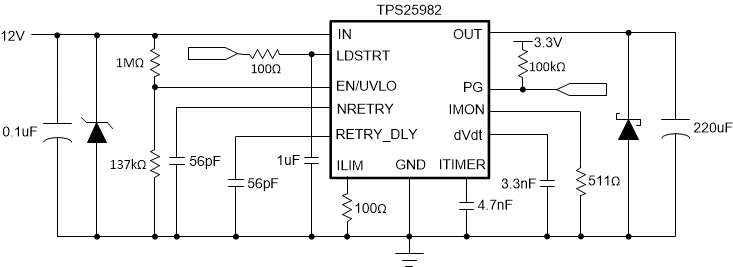JAJSGC8B October 2018 – January 2020 TPS25982
PRODUCTION DATA.
- 1 特長
- 2 アプリケーション
- 3 概要
- 4 改訂履歴
- 5 デバイス比較表
- 6 概要 (続き)
- 7 Pin Configuration and Functions
- 8 Specifications
-
9 Detailed Description
- 9.1 Overview
- 9.2 Functional Block Diagram
- 9.3 Feature Description
- 9.4 Fault Response
- 9.5 Device Functional Modes
-
10Application and Implementation
- 10.1 Application Information
- 10.2
Typical Application: Standby Power Rail Protection in Datacenter Servers
- 10.2.1 Design Requirements
- 10.2.2
Detailed Design Procedure
- 10.2.2.1 Device Selection
- 10.2.2.2 Setting the Current Limit Threshold: RILIM Selection
- 10.2.2.3 Setting the Undervoltage Lockout Set Point
- 10.2.2.4 Choosing the Current Monitoring Resistor: RIMON
- 10.2.2.5 Setting the Output Voltage Ramp Time (TdVdt)
- 10.2.2.6 Setting the Load Handshake (LDSTRT) Delay
- 10.2.2.7 Setting the Transient Overcurrent Blanking Interval (tITIMER)
- 10.2.2.8 Setting the Auto-Retry Delay and Number of Retries
- 10.2.3 Application Curves
- 10.3 System Examples
- 11Power Supply Recommendations
- 12Layout
- 13デバイスおよびドキュメントのサポート
- 14メカニカル、パッケージ、および注文情報
パッケージ・オプション
メカニカル・データ(パッケージ|ピン)
- RGE|24
サーマルパッド・メカニカル・データ
- RGE|24
発注情報
11.1 Transient Protection
In the case of a short circuit and overload current limit when the device interrupts current flow, the input inductance generates a positive voltage spike on the input, and the output inductance generates a negative voltage spike on the output. The peak amplitude of voltage spikes (transients) is dependent on the value of inductance in series to the input or output of the device. Such transients can exceed the absolute maximum ratings of the device if steps are not taken to address the issue. Typical methods for addressing transients include:
- Minimize lead length and inductance into and out of the device.
- Use a large PCB GND plane.
- Use a Schottky diode across the output to absorb negative spikes.
- Use a low value ceramic capacitor CIN = 0.001 μF to 0.1 μF to absorb the energy and dampen the transients. The approximate value of input capacitance can be estimated using Equation 30.

where
- VIN is the nominal supply voltage
- ILOAD is the load current
- LIN equals the effective inductance seen looking into the source
- CIN is the capacitance present at the input
Some of the applications may require the addition of a Transient Voltage Suppressor (TVS) to prevent transients from exceeding the absolute maximum ratings of the device. A typical circuit implementation with optional protection components (a ceramic capacitor, TVS and Schottky diode) is shown in Figure 72.
 Figure 72. Typical Circuit Implementation With Optional Protection Components
Figure 72. Typical Circuit Implementation With Optional Protection Components